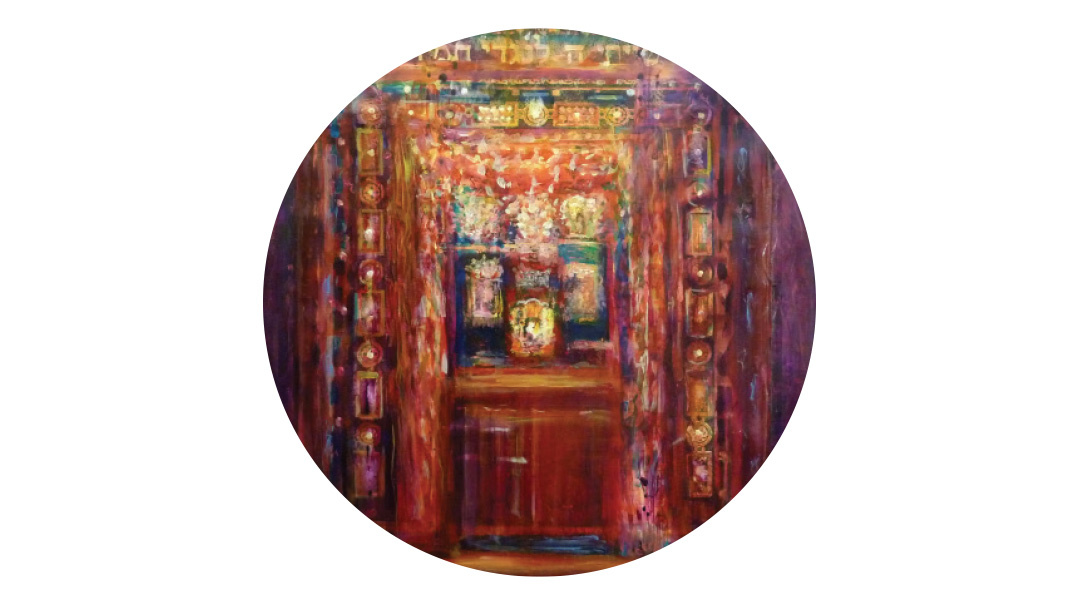On the Derech

Our own wavering in emunah opens the door to Amalek

Kol ha’olam kulo gesher tzar meod. These popular words, attributed to Rav Nachman of Breslov, describe our world as a bridge that must be crossed by a traveler on the way to his destination. What is the significance of this metaphor?
To a traveler, a bridge does not signify his journey’s end, for it serves as a span, or connection, to another point on his itinerary. Similarly, our world is a prelude to the World to Come. When we view our temporal life as a bridge to eternity, it makes all the difference. Life becomes a journey of great opportunity and profound import.
It’s for this very reason that the yetzer hara, our evil inclination, seeks to obscure this recognition. The forces of evil maintain that this world is an end in itself and deny that we are on the way to the ultimate goal of Olam Haba.
Amalek was one of these voices. We are instructed to wipe out the memory of Amalek, and we are told that there will be “war for Hashem against Amalek from generation to generation” (Shemos 17:16). What’s the purpose of this protracted struggle? If it’s so important to blot out their existence, why doesn’t Hashem, who is Almighty and Infinite, do away with Amalek once and for all?
Journey Mindset
Amalek’s initial crime was attacking the Jewish nation so soon after the exodus from Egypt and the splitting of the sea. In doing so, Amalek sought to diminish the worldwide impact of these miracles. The Torah exhorts us, “Zachor es asher asah lecha Amalek baderech b’tzeis’chem miMitzrayim, [Remember what Amalek did to you on the way, after you left Mitzrayim.]” The word, baderech, “en route,” is repeated in the next verse: asher korcha baderech, they came upon you “on the way.” The repetition indicates that “baderech” does more than provide a geographical context. Rav Moshe Shapira tells us that it’s a key to understanding Amalek’s mindset and the position of this nation in Hashem’s world.
The image of Klal Yisrael “en route” denotes a purposeful journey toward a goal. It implies that we have a directed and designated itinerary, that we know where we are going, and that we know how to get there. It speaks of Hashem’s plan for the ultimate tikkun olam, rectification of the world, and the engagement of each individual in that plan.
Amalek, the embodiment of evil in this world, interrupts our journey. Amalek comes to create a disconnect between us and HaKadosh Baruch Hu, to divert our focus and to break our stride. It seeks to weaken mankind’s belief in Hashem’s cosmic design, and to diminish our involvement and enthusiasm in His great plan.
These intentions of Amalek are apparent from the Torah’s words, asher korcha baderech. Korcha derives from mikreh, happenstance. While other nations were astonished by the miracles at the sea, Amalek argued that the Jewish nation’s success was happenstance, a random event not orchestrated by Hashem. They sought to discredit the concept of Hashgachah pratis, Hashem’s individualized supervision of our lives, by demonstrating that Klal Yisrael was not untouchable and could be attacked. This Amalek worldview is expressed in the word “Purim.” Haman cast lots — hipil pur — underscoring his belief in blind fate.
Another translation of korcha derives from kerirus, coldness. Amalek sought to “cool us off,” to dampen our enthusiasm for avodas Hashem. The Slonimer Rebbe points out a historical pattern: Amalek strikes when there is an opportunity for tikkun olam. So in the Midbar, they attacked before Matan Torah; in the time of Shaul Hamelech, Amalek waged war prior to the building of the first Beis Hamikdash; during the Purim story, Haman’s plot preceded Klal Yisrael’s return to Yerushalayim and rebuilding of the Beis Hamikdash.
Alternately, Amalek surfaces when we are lukewarm — weak and uninspired — in our own avodas Hashem. The Midbar attack followed an ordeal in Refidim, where the nation despaired of finding water and was given the well of Miriam. The story ends with these words: “They named the place Masah U’merivah, because they had quarreled with Hashem there, saying, ‘Is Hashem in our midst or not?’ ”
The very next verse begins with the words, “Vayavo Amalek — and Amalek came.” Rashi and the Maharal note that the juxtaposition of these two verses indicates a cause and effect. When the people felt disconnected from Hashem, when they expressed doubt as to whether He was “in their midst” — directly involved with their daily lives and needs — Amalek came. It was as if they had beckoned to him. The name of the place, Refidim, alludes to the fact that rafu yedeihem min haTorah, their hands became weak in Torah and mitzvos. The message: Amalek comes when he feels “invited,” our own wavering in emunah opens the door to Amalek, the classic denier of Hashgachah pratis.
The Ladder’s Message of Movement
We can expand our understanding of the baderech mindset by observing a ladder, a structure similar to a bridge. Although a ladder’s orientation is vertical, it, too, facilitates movement and progress. Furthermore, both the bridge and the ladder serve as connectors. They link two areas, allowing the traveler or climber to access previously unreachable zones.
In fact, the most famous ladder in our history carried a message similar to the baderech concept. It appeared to Yaakov Avinu in a dream (Bereishis 28) when he fled from Eisav’s wrath and headed to Charan, where he was destined to marry and form the first bayis neeman b’Yisrael. (Yaakov was the first of the Avos whose children all merited to be part of Klal Yisrael — he didn’t have a Yishmael or an Eisav.) The ladder dream imparted a number of vital messages to our patriarch at this crossroads of his life.
The Torah relates that this ladder spanned Heaven and Earth, and that malachim, angels, were going up and down the ladder. The Ramban tells us, based on a midrash, that this ladder represented the timeline of Jewish history, and that the malachim portrayed the rise and fall of the four empires which exiled our people.
Thus Yaakov’s journey to Charan was not only the story of his personal exile: The revelation of the ladder reflects the collective journey of his children, Bnei Yisrael, who would travel through four exiles and undergo various trials as part of Hashem’s great scheme for mankind, which began at Creation and will culminate in the Messianic Era and the End of Days.
Linking Heaven and Earth
But there is yet another, crucial, interpretation of the ladder dream. The Torah describes the ladder as a structure that was mutzav artzah, standing on the ground, v’rosho magia hashamaimah, and whose head reached the heavens. Thus it linked heaven and earth.
The ladder is delivering a critical message to Yaakov. The shamayim and aretz are not two isolated expanses. A person is capable — and required — to be grounded on earth, engaging in physical activities—and still reach the heavenly spheres. It was Hashem’s will for Yaakov to marry and have children, to create a family of mortal human beings whose spirits would soar to unimaginable heights.
Rav Moshe Shapira explains that Amalek’s philosophy is diametrically opposed to this perspective. Amalek argues that there is no inherent kedushah in Olam Hazeh, that mortals cannot reach Shamayim. The Midrash tells us that Amalek particularly scoffed at the mitzvah of circumcision, for it represents the potential of man’s own flesh and how it can be used for a mitzvah. It is for this reason that the mitzvah is called bris milah; with it, man enters into a covenant with Hashem. When Amalek accosted us baderech, their message was that there is no derech, no channel, that connects the mortal with the Divine, the physical world with the spiritual realm.
Battling Amalek
Amalek’s two platforms of attack are intertwined and can be expressed in one statement: Amalek opposes, undermines, and weakens our enthusiasm for our relationship with Hashem. A relationship runs in two directions, and Amalek fights the connection from both points of view: He fights against emunah in Hashgachah pratis — the system by which Hashem relates to man; he fights against kedushah, the concept of elevating the physical to serve Hashem — the manner by which we relate to Hashem.
The celebration of Purim by feasting and becoming intoxicated underscores these two themes of emunah and kedushah as well. When we drink ad d’lo yada, until we can no longer tell the difference between arur Haman and baruch Mordechai, we are relinquishing control over our own judgment, and acknowledging that Hashem runs the world according to His agenda and His perspective. And when we use food and drink to bring us to joy and acceptance of His will, we are promoting the use of the material as a medium to serve Hashem.
In the Midbar battle against Amalek, Yehoshua fought with the army in the valley, and Moshe stood on the mountain with raised arms, in full view of the soldiers. In direct contrast to the hands of the nation, which “became weak in Torah,” Moshe’s hands were firm and decisive: When he pointed to the heavens, he reminded them that Hashem is in charge of this war, and of the entire cosmos. And by stretching his hands toward the heavens, he demonstrated the possibility of rosho magia hashamaimah, of our rising above our own physicality.
Yet the Midrash comments that Moshe’s hand were not always raised upward, and Klal Yisrael did not always have the upper hand; when his hands fell to his sides, they began losing the war. The war against Amalek has its ups and downs. It’s a protracted struggle that will indeed last “from generation to generation,” precisely because it’s ours to wage — in our minds and hearts — until the end of days. Will we cleave to Hashem and His program for our lives? Will we elevate the world?
We’ll need to struggle to maintain emunah and achieve kedushah. We’ll falter at times. The bridge will twist and turn, the ladder will seem endless. Amalek will sometimes feel “invited” to enter our hearts, and he’ll voice his disenchantment and irreverence: “Who cares? What does it matter? What difference does it make?” If we remember that we are baderech, we’ll know the answer: “Hashem cares — about us. We matter, and our journey is crucial. And that makes all the difference, in this world and for all eternity.”
Sources included the writings of the Nesivos Shalom, Rav Moshe Shapira, Rav Yisroel Belsky, and Rav Zev Leff
Originally featured in Family First, Issue 580. Mrs. Shani Mendlowitz is a teacher at Bais Yaakov Seminary in Montreal, and is a popular lecturer for adults.
Oops! We could not locate your form.







